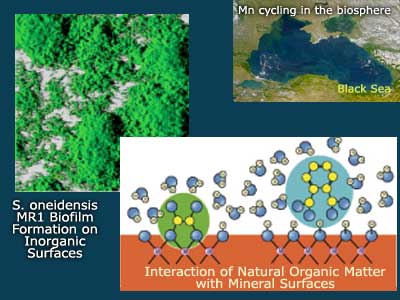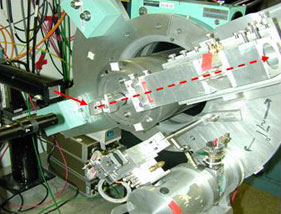| Fundamental
and applied research
 |
Why synchrotrons for environmental science? Molecular
Environmental Science (MES) research at SSRL focuses on the fundamental interfacial,
molecular- and nano-scale processes that control contaminant and nutrient cycling
in the biosphere with the goal of elucidating global elemental cycles and anthropogenic
influences on the environment. Key areas of investigation include the: (a) Structural
chemistry of water and dissolved solutes, (b) Structural chemistry and reactivity
of complex natural environmental materials with respect to heavy metals and metalloids
(biominerals, Fe- and Mn-oxides, biofilms, and organic materials), (c) Reactions
at environmental interfaces, including sorption, precipitation and dissolution
processes that affect the bioavailability of heavy metals and other contaminants,
and (d) Microbial transformations of metals and anions. SSRL-based MES research
utilizes synchrotron-based x-ray absorption spectroscopy (XAS), x-ray diffraction
(XRD), small-angle x-ray scattering (SAXS), x-ray standing wave (XSW) spectroscopy,
and photoemission spectroscopy (PES) because of their unique capabilities to probe
structure/composition relationships in complex, non-crystalline, and dilute materials. Molecular
Environmental Science (MES) research at SSRL focuses on the fundamental interfacial,
molecular- and nano-scale processes that control contaminant and nutrient cycling
in the biosphere with the goal of elucidating global elemental cycles and anthropogenic
influences on the environment. Key areas of investigation include the: (a) Structural
chemistry of water and dissolved solutes, (b) Structural chemistry and reactivity
of complex natural environmental materials with respect to heavy metals and metalloids
(biominerals, Fe- and Mn-oxides, biofilms, and organic materials), (c) Reactions
at environmental interfaces, including sorption, precipitation and dissolution
processes that affect the bioavailability of heavy metals and other contaminants,
and (d) Microbial transformations of metals and anions. SSRL-based MES research
utilizes synchrotron-based x-ray absorption spectroscopy (XAS), x-ray diffraction
(XRD), small-angle x-ray scattering (SAXS), x-ray standing wave (XSW) spectroscopy,
and photoemission spectroscopy (PES) because of their unique capabilities to probe
structure/composition relationships in complex, non-crystalline, and dilute materials.
| 



